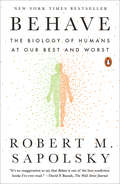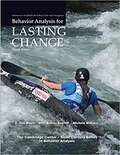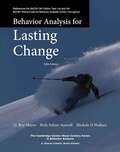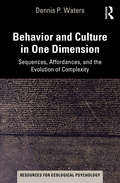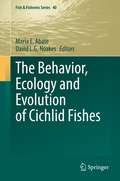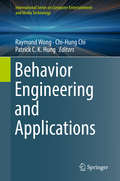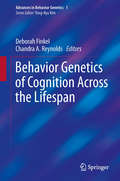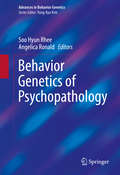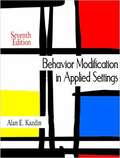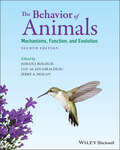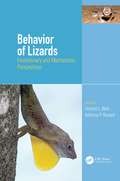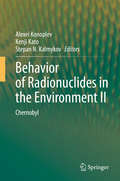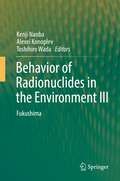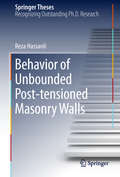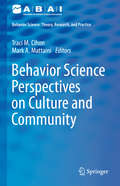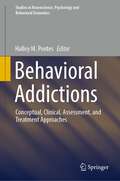- Table View
- List View
Begutachtung psychischer Störungen
by Frank Schneider Helmut Frister Dirk OlzenBegutachtungen von Menschen mit psychischen Störungen sind anspruchsvoll und gelten als schwierig. Das vorliegende Standardwerk bietet deshalb einen kompakten und gleichzeitig praxisnahen Leitfaden für ärztliche und psychologische Sachverständige, aber auch eine unverzichtbare und umfassende Grundlage für Juristen. Denn richtige und faire Entscheidungen der Gerichte können nur gefällt werden, wenn sich Mediziner, Psychologen und Juristen untereinander verständigen können. Dieses Buch leistet einen wesentlichen Beitrag zu diesem nicht immer einfachen, aber notwendigen und nicht zuletzt besonders interessanten und spannenden interdisziplinären Austausch. Das Werk zeichnet sich aus durch eine praxisbezogene, verständliche und klare Darstellung der wesentlichen Aspekte der psychiatrischen und psychologischen Begutachtung, ausführliche Beispielgutachten sowie zahlreiche Fallbeispiele aus der Praxis viele Tipps zum Erstellen eines Gutachtens die Darstellung des aktuellen Stands der medizinischen, psychologischen und juristischen Literatur, inklusive der neuesten Rechtsprechung und Gesetzgebung. Das Buch ist ein wertvoller Begleiter für Mediziner, Psychologen, Juristen und alle anderen Interessierten, die mit psychiatrischen und psychologischen Gutachten zu tun haben. Mit der fünften Auflage wurde es erneut überarbeitet und aktualisiert. So wird beispielsweise bereits Bezug genommen auf die künftige ICD-11-Klassifikation, es werden aktuelle gesetzliche Änderungen, z.B. im Betreuungsrecht und bei der Behandlung von Kindern mit Varianten der Geschlechtsentwicklung (§ 1631e BGB), das neue 14. Buch des Sozialgesetzbuches, das neue Strafrechtsbezogene Unterbringungsgesetz NRW, die geänderten Voraussetzungen für die Unterbringung in einer Entziehungsanstalt (§ 64 StGB) sowie geänderte juristische Terminologien und aktuelle Literatur berücksichtigt.
Behandlungsfehler und Haftpflicht in der Viszeralchirurgie
by Hans-Peter Bruch Jörg Heberer Joachim Jähne Jürgen BauchDie Vermeidung von Behandlungsfehlern und der Umgang mit haftungsrechtlichen Konsequenzen ist für Chirurgen ein Thema von wachsender Bedeutung. In dem Band werden die rechtlichen Grundlagen, Verhaltensregeln und Verfahren der rechtlichen Klärung für die Viszeralchirurgie umfassend aufgearbeitet. Renommierte Kliniker beschreiben mögliche Behandlungsfehler, liefern Hinweise zur Fehlervermeidung und zeigen die rechtlichen Konsequenzen auf. Dabei werden sowohl konventionelle Operationsverfahren als auch die minimal invasive Chirurgie berücksichtigt.
Behave: The Biology of Humans at Our Best and Worst
by Robert M. SapolskyWhy do we do the things we do?Over a decade in the making, this game-changing book is Robert Sapolsky's genre-shattering attempt to answer that question as fully as perhaps only he could, looking at it from every angle. Sapolsky's storytelling concept is delightful but it also has a powerful intrinsic logic: he starts by looking at the factors that bear on a person's reaction in the precise moment a behavior occurs, and then hops back in time from there, in stages, ultimately ending up at the deep history of our species and its genetic inheritance.And so the first category of explanation is the neurobiological one. What goes on in a person's brain a second before the behavior happens? Then he pulls out to a slightly larger field of vision, a little earlier in time: What sight, sound, or smell triggers the nervous system to produce that behavior? And then, what hormones act hours to days earlier to change how responsive that individual is to the stimuli which trigger the nervous system? By now, he has increased our field of vision so that we are thinking about neurobiology and the sensory world of our environment and endocrinology in trying to explain what happened.Sapolsky keeps going--next to what features of the environment affected that person's brain, and then back to the childhood of the individual, and then to their genetic makeup. Finally, he expands the view to encompass factors larger than that one individual. How culture has shaped that individual's group, what ecological factors helped shape that culture, and on and on, back to evolutionary factors thousands and even millions of years old.The result is one of the most dazzling tours de horizon of the science of human behavior ever attempted, a majestic synthesis that harvests cutting-edge research across a range of disciplines to provide a subtle and nuanced perspective on why we ultimately do the things we do...for good and for ill. Sapolsky builds on this understanding to wrestle with some of our deepest and thorniest questions relating to tribalism and xenophobia, hierarchy and competition, morality and free will, and war and peace. Wise, humane, often very funny, Behave is a towering achievement, powerfully humanizing, and downright heroic in its own right.
Behavior Analysis for Lasting Change
by G. Roy Mayer Beth Sulzer-Azaroff Michele WallaceBehavior Analysis for Lasting Change
Behavior Analysis for Lasting Change
by Michele Wallace Beth Sulzer-Azaroff G. Roy MayerBehavior Analysis for Lasting Change
Behavior and Culture in One Dimension: Sequences, Affordances, and the Evolution of Complexity (Resources for Ecological Psychology Series)
by Dennis WatersBehavior and Culture in One Dimension adopts a broad interdisciplinary approach, presenting a unified theory of sequences and their functions and an overview of how they underpin the evolution of complexity.Sequences of DNA guide the functioning of the living world, sequences of speech and writing choreograph the intricacies of human culture, and sequences of code oversee the operation of our literate technological civilization. These linear patterns function under their own rules, which have never been fully explored. It is time for them to get their due. This book explores the one-dimensional sequences that orchestrate the structure and behavior of our three-dimensional habitat. Using Gibsonian concepts of perception, action, and affordances, as well as the works of Howard Pattee, the book examines the role of sequences in the human behavioral and cultural world of speech, writing, and mathematics. The book offers a Darwinian framework for understanding human cultural evolution and locates the two major informational transitions in the origins of life and civilization. It will be of interest to students and researchers in ecological psychology, linguistics, cognitive science, and the social and biological sciences.
Behavior and Culture in One Dimension: Sequences, Affordances, and the Evolution of Complexity (Resources for Ecological Psychology Series)
by Dennis P. WatersBehavior and Culture in One Dimension adopts a broad interdisciplinary approach, presenting a unified theory of sequences and their functions and an overview of how they underpin the evolution of complexity. Sequences of DNA guide the functioning of the living world, sequences of speech and writing choreograph the intricacies of human culture, and sequences of code oversee the operation of our literate technological civilization. These linear patterns function under their own rules, which have never been fully explored. It is time for them to get their due. This book explores the one-dimensional sequences that orchestrate the structure and behavior of our three-dimensional habitat. Using Gibsonian concepts of perception, action, and affordances, as well as the works of Howard Pattee, the book examines the role of sequences in the human behavioral and cultural world of speech, writing, and mathematics. The book offers a Darwinian framework for understanding human cultural evolution and locates the two major informational transitions in the origins of life and civilization. It will be of interest to students and researchers in ecological psychology, linguistics, cognitive science, and the social and biological sciences.
The Behavior, Ecology and Evolution of Cichlid Fishes (Fish & Fisheries Series #40)
by Maria E. Abate David L. G. NoakesThis volume constitutes the most recent and most comprehensive consideration of the largest family of bony fishes, the Cichlidae. This book offers an integrated perspective of cichlid fishes ranging from conservation of threatened species to management of cichlids as invasive species themselves. Long-standing models of taxonomy and systematics are subjected to the most recent applications and interpretations of molecular evidence and multivariate analyses; and cichlid adaptive radiations at different scales are elucidated. The incredible diversity of endemic cichlid species in African lakes is revisited as possible examples of sympatric speciation and as serious cases for management in complex anthropogenic environments. Extreme hydrology and bathymetry as driver of micro-allopatric speciation is explored in the African riverine hotspot of diversity of the lower Congo River. Dramatic new molecular evidence draws attention to the complex taxonomy and systematics of Neotropical cichlids including the crater lakes of Central America. Molecular genetics, genomics, imaging tools and field study techniques assess the roles of natural, sexual and kin selection in shaping cichlid traits and beyond. The complex behavioral adaptations of cichlids are considered from a number of sub-disciplines including sensory biology, neurobiology, development, and evolutionary ecology. Most importantly, this volume puts forth a wealth of new interpretations, explanatory hypotheses and proposals for practical management and applications that will shape the future for these remarkable fishes in nature as well as their use as models for the study of biology.
Behavior Engineering and Applications (International Series on Computer Entertainment and Media Technology)
by Raymond Wong Chi-Hung Chi Patrick C. HungMany industrial applications built today are increasingly using emerging behavior engineering technologies: this book looks at various research and practical issues for researchers and students working in computer science and engineering, and for industry technology providers interested in behavior engineering and applications. Behavior Engineering and Applications encompasses intelligent and efficient computational solutions, including models, architectures, algorithms and specific applications, focused on processing, discovering, understanding and analyzing the behavior captured by the above data. Focusing on applying any engineering paradigm to systemically process, discover, understand and analyze these data, this book also addresses problems in a variety of areas and applications that related to behavior engineering.This book includes chapters derived from selected papers from The 2016 International Conference on Behavior Engineering (ICBE), as well as separate contributions the editors selected cutting-edge research related to behavior engineering.
Behavior Genetics of Cognition Across the Lifespan (Advances in Behavior Genetics #1)
by Deborah Finkel Chandra A. ReynoldsAlong with psychopathology, cognition has been one of the primary phenotypic focal points of the field of behavior genetics since its inception. Francis Galton's 1874 examination of eminent families in Britain was among the earliest attempts to investigate whether cognitive achievements run in families. This volume presents current methodologies for understanding cognitive abilities that move beyond the outdated nature vs. nurture paradigm. Recent advances in both collection and statistical modeling of twin data, particularly longitudinal twin data, make this an especially advantageous moment to produce a work that presents a collection of the groundbreaking research on cognitive abilities across the lifespan. This volume presents an overview of the current state of quantitative and molecular genetic investigations into the many facets of cognitive performance and functioning across the lifespan.
Behavior Genetics of Psychopathology (Advances in Behavior Genetics #2)
by Soo Hyun Rhee Angelica RonaldAs a dynamic, interdisciplinary field, behavior genetics and its evolution are being followed closely by scientists across the psychological and medical domains. The discoveries surrounding the human genome and the advancement in molecular genetic technologies have led to studies becoming increasingly sophisticated and yielding yet more conclusive and useful results. This is certainly the case in the area of child and adult psychopathology. Behavior Genetics of Psychopathology summarizes the state of the field, examining the role of genes and environment as they affect common neurodevelopmental and psychiatric conditions. Emphasizing key research areas (comorbidities, twin studies, the integration of methods), the book assesses the current literature, offers up-to-date findings, sorts through lingering controversies, and identifies a clear future agenda for the field. Expertly-written chapters focus on issues of both general salience that shape behavior genetics of psychopathology, to specific disorders of major clinical importance, among them: ADHD: the view from quantitative genetic research. Autism spectrum disorders and their complex heterogeneity Genetic influences on anxiety and depression in childhood and adolescence. Evidence for etiologically-defined subgroups within the construct of antisocial behavior. Sleep and psychopathology: the reasons for their co-occurrence. Behavioral genetic approaches to the etiology of comorbidity. Epigenetics of psychopathology. This combination of timeliness and depth of coverage make Behavior Genetics of Psychopathology a frontline resource for behavior geneticists, psychologists, psychiatrists, and neuroscientists, and is perfectly suited to graduate students looking to join these fields.
Behavior Genetics of Temperament and Personality (Advances in Behavior Genetics)
by Kimberly J. Saudino Jody M. GanibanThis volume examines behavioral genetic research on temperament and personality from a number of perspectives. It takes a developmental perspective on a number of issues across the lifespan, focusing on personality and temperament. The first section focuses on the development of temperament and personality. Typically this has involved exploring genetic and environmental contributions to phenotypic stability and instability, but more recently there has been research that examines the etiology of intra-individual change/growth trajectories. The second section examines genetic and environmental contributions to the association between temperament and personality and other behaviors. The third and fourth sections discuss genotype-environment correlations and interactions, and introduces the reader to molecular genetics research on temperament and personality. Chapter 11 will discuss the significance of this type of research and Chapter 12 will provide an example of specific line of research exploring genes associated with temperament.
Behavior Modification in Applied Settings
by Alan E. KazdinContinuing the tradition of excellence established in previous editions, distinguished researcher, practitioner, and educator Alan Kazdin integrates pioneering and recent research with discussions and examples for altering behavior and the conditions that influence their effectiveness. he Seventh Edition reflects several developments within the field of behavior modification, without diminishing an essential emphasis on applied research and intervention techniques.
The Behavior of Animals: Mechanisms, Function, and Evolution
by Johan J. Bolhuis Luc-Alain Giraldeau Jerry A. HoganThe Behavior of Animals An updated view of animal behavior studies, featuring global experts The Behavior of Animals, Second Edition provides a broad overview of the current state of animal behavior studies with contributions from international experts. This edition includes new chapters on hormones and behavior, individuality, and human evolution. All chapters have been thoroughly revised and updated, and are supported by color illustrations, informative callouts, and accessible presentation of technical information. Provides an introduction to the study of animal behavior Looks at an extensive scope of topics- from perception, motivation and emotion, biological rhythms, and animal learning to animal cognition, communication, mate choice, and individuality. Explores the evolution of animal behavior including a critical evaluation of the assumption that human beings can be studied as if they were any other animal species. Students will benefit from an updated textbook in which a variety of contributors provide their expertise and global perspective in specialized areas
Behavior of Lizards: Evolutionary and Mechanistic Perspectives
by Vincent Bels Anthony RussellKey features: Presents a contemporary snapshot of the mechanisms underlying the evolution and adaptation of behavior Explores how genetics, epigenetics, development, and environment shape behavior Discusses a broad range of behavioral repertoires and responses, including those related to thermoregulatory, foraging, predatory, displaying, social and escape strategies. Examines physiological and sensory mechanisms Covers the effects of various aspects of global change on behavior, with chapters that focus on the impacts of climate change on hydroregulatory behavior and behavioral responses to the effects of habitat alteration resulting from human-mediated change and colonization by invasive species. Lizards serve as focal organisms for many of biological questions related to evolution, ecology, physiology, and morphology. They are studied at multiple spatial and temporal scales, from the individual to the community level. This book, authored by expert contributors from around the world, explores behaviors underlying the evolution and adaptation of these organisms. It covers conceptual, empirical, and methodological approaches to the understanding of the role that natural and sexual selection play in molding the behavioral traits of lizards. This thorough, illustrated reference should stimulate discussion of the conceptual and methodological approaches for studying the behavioral traits of these fascinating and highly diverse vertebrates.
Behavior of Radionuclides in the Environment I: Function of Particles in Aquatic System
by Stepan N. Kalmykov Kenji Kato Alexei KonoplevThe 3-volume set highlights the behavior of radionuclides in the environment and focusing on the development of related fields of study, including microbiology and nanoscience. In this context, it discusses the behavior of radionuclides released in areas of Lake Karachai in Ural, and those released as a result of Chernobyl accident (1986), and in Fukushima (2011). Volume I presents the experiences gained in South Urals (“Mayak” plant, Lake Karachai), providing a scientific basis for more precise understanding of the behavior of radionuclides in complex subsurface environments. On the basis of monitoring data, it examines the pathways of radionuclide migration and the influence of the geological environment and groundwater on the migration, with a particular focus on particles from the nanoscale to microscale. It also discusses the function of microbes and microscale particles, from their direct interaction with radionuclides to their ecological role in changing the physic-chemical condition of a given environment. Lastly, the protective properties of geological media are also characterized, and mathematical modeling of contaminant migration in the area of Lake Karachai is used to provide information regarding the migration of radionuclides.
Behavior of Radionuclides in the Environment II: Chernobyl
by Alexei Konoplev Kenji Kato Stepan N. KalmykovThis is Volume II in a three-volume set on the Behavior of Radionuclides in the Environment, focusing on Chernobyl. Now, so many years after the Chernobyl accident, new data is emerging and important new findings are being made. The book reviews major research achievements concerning the behavior of Chernobyl-derived radionuclides, including their air transport and resuspension, mobility and bioavailability in the soil-water environment, vertical and lateral migration in soils and sediments, soil-to-plant and soil-to-animal transfer, and water-to-aqueous biota transfer. The long-term dynamics of radionuclides in aquatic ecosystems are also discussed, in particular, the heavily contaminated cooling pond of the Chernobyl Nuclear Power Plant, which is in the process of being decommissioned. Lessons learned from long-term research on the environmental behavior of radionuclides can help us understand the pathways of environmental contamination, which, in turn, will allow us to improve methods for modeling and predicting the long-term effects of pollution. This book features a wealth of original data and findings, many of which have never been published before, or were not available internationally. The contributing authors are experts from Ukraine, Russia and Belarus with more than 30 years of experience investigating Chernobyl-derived radionuclides in the environment. The content presented here can help to predict the evolution of environmental contamination following a nuclear accident, and specifically the Fukushima Dai-ichi nuclear power plant accident.
Behavior of Radionuclides in the Environment III: Fukushima
by Kenji Nanba Alexei Konoplev Toshihiro WadaThis book, the third in the series Behavior of Radionuclides in the Environment, is dedicated to Fukushima. Major findings from research since 2011 are reviewed concerning the behavior of radionuclides released into the environment due to the Fukushima Dai-ichi Nuclear Power Plant accident, including atmospheric transport and fallout of radionuclides, their fate, and transport in the soil-water environment, behavior in freshwater, coastal and marine environment, transfer in the terrestrial and agricultural environment. Volume III discusses not only radionuclides dynamics in the environment in the short- and mid-term, but also modeling and prediction of long-term time changes.Along with reviews, the book contains original data and results not published previously. It was spearheaded by the authors from the Institute of Environmental Radioactivity at Fukushima University, established two years after the Fukushima accident, with their collaborators from Japan, Russia, and Ukraine. The knowledge emerging from the studies of the environmental behavior of Fukushima-derived radionuclides enables us to move forward in understanding mechanisms of environmental contamination and leads to better modeling and prediction of long-term pollution effects in general.
The Behavior of Texas Birds
by Kent RylanderWhether it's the sudden, plunging dives of Brown Pelicans, the singing and aerial displays of Northern Mockingbirds, or the communal nesting of Purple Martins, innate and learned behaviours are some of the most fascinating things to observe in Texas birds. Even casual birdwatchers eventually ask, ""why do they do that?"" while serious birders and ornithologists seek to understand all the behaviours involved in feeding, flying, mating, and rearing young. But until now, it has been hard to find this information in one handy source. In this comprehensive, yet easy-to-use book, Kent Rylander distils data from many sources to provide an authoritative guide to the behaviour of Texas birds. He begins by explaining the principles of animal behaviour and illustrating how they can be applied to interpreting bird behaviours in the field. The majority of the book is devoted to accounts of more than 400 species of birds that are most likely to be encountered by Texas birdwatchers. Each account describes such behaviours as feeding, courtship, parenting, and other behaviours that are significant for that species.
Behavior of Unbounded Post- tensioned Masonry Walls (Springer Theses)
by Reza HassanliThis book reports on a comprehensive analytical, experimental and numerical study on the flexural response of post-tensioned masonry walls under in-plane loads. It explores an important mechanism in this new generation of structural walls, called “Self-centering”. This mechanism can reduce residual drifts and structural damage during earthquake ground motion, and is particularly favorable for structures which are designed for immediate occupancy performance levels. The book reports on the development and verification of a finite element model of post-tensioned masonry walls. It describes a detailed parametric study to predict the strength of post-tensioned masonry walls. New design methodologies and expressions are developed to predict the flexural strength and force-displacement response of post-tensioned masonry. Experimental study is carried out to better understand the behavior of post-tensioned masonry walls and also to evaluate the accuracy of the proposed design procedure and expressions. The book also includes an introduction to current research on unbounded post-tensioned masonry walls, together with an extensive analysis of previously published test results.
Behavior Science Perspectives on Culture and Community (Behavior Analysis: Theory, Research, and Practice)
by Traci M. Cihon Mark A. MattainiAll science proceeds by progressively building on the work of others while remaining open to new discoveries and challenging existing conceptual frameworks. The same is true of culturo-behavior science.This textbook presents the scientifically rigorous work of the last several decades that has taken a behavior-analytic view of social and cultural processes, with an eye for contributions that address social and cultural issues. The chapters herein explore and elaborate on the history, theories, and methodologies of culturo-behavior science and those of its researchers and practitioners. Throughout this volume, the authors intentionally prompt students to both learn from and question the current theory and methods while shaping their own research and practice.This book presents multiple intersecting perspectives intended for graduate-level students of behavior analysis. Contributors to this volume include many of the major scholars and practitioners conducting research and/or practicing in communities and larger cultural systems. Their work is scientifically guided, systemic, and ecologically valid; it includes basic research as well as efforts having applications in community health, sustainability, environmental issues, and social justice, among other matters. There is material here to support specialists preparing to do research or practice within community and cultural-level systems. As well, students who intend to do direct and clinical work will find the background they need to make contributions to the field as engaged, informed citizens.
Behavioral Addictions: Conceptual, Clinical, Assessment, and Treatment Approaches (Studies in Neuroscience, Psychology and Behavioral Economics)
by Halley M. PontesThis book provides a holistic evidence-based perspective on conceptual, clinical, assessment, and treatment aspects of key non-substance-based addictive disorders related to: gambling, gaming, social media, smartphone, internet, love, sex, exercise, work, and shopping. Each chapter focuses on a different addictive disorder and is structured in a user-friendly way to enable the reader fast navigation, yet the main aspects of the respective disorders are covered in the necessary depth. All in all, this book offers a timely, self-contained introduction to both key concepts and the latest scientific developments in behavioral addictions. It addresses mental health practitioners, researchers in psychology, neuroscience and communication, and undergraduate and postgraduate students alike.
The Behavioral Biology and Conservation of Goitered Gazelles (Gazella subgutturosa)
by David BlankThis comprehensive and lavishly illustrated book summarizes all known information on the Goitered Gazelle (Gazella subgutturosa), one of the world's most endangered antelopes. It includes information on topics such as feeding ecology, behavior, vocalizations, parasites and diseases, and conservation. This research monograph will be of interest to professional researchers of ungulates, university staff, students, and naturalists.
Behavioral Biology of Laboratory Animals
by Kristine Coleman Steven J. SchapiroThis 30-chapter volume informs students and professionals about the behavioral biology of animals commonly housed in laboratory and other captive settings. Each species evolved under specific environmental conditions, resulting in unique behavioral patterns, many of which are maintained in captivity even after generations of breeding. Understanding natural behavior is therefore a critical part of modern animal care practices. The descriptions, data, guidance, resources, and recommendations in this book will help the reader understand their animals better, refine the care and treatment that they receive, and improve the well-being, welfare, and wellness of their animals. The book is divided into three sections, all focusing on aspects of the behavioral biology of animals found in laboratories and related research settings. After five introductory chapters, 25 chapters are dedicated to specific taxonomic groups (including mice, zebrafish, zebra finches, reptiles, macaques) while a concluding section of ethograms provides a centralized resource for those interested in understanding, and potentially quantifying, animal behavior. The Behavioral Biology of Laboratory Animals will provide anyone working in maintenance, care, and/or research programs that involve laboratory animals with information about the way the animals live in the wild, and the way that they should live in captive research settings. Many of the guidelines and recommendations will also be valuable to those managing and working with animals in other environments, including zoological parks, aquaria, and sanctuaries.
Behavioral Ecology and the Transition to Agriculture
by Douglas J. Kennett Bruce WinterhalderThis innovative volume is the first collective effort by archaeologists and ethnographers to use concepts and models from human behavioral ecology to explore one of the most consequential transitions in human history: the origins of agriculture. Carefully balancing theory and detailed empirical study, and drawing from a series of ethnographic and archaeological case studies from eleven locations--including North and South America, Mesoamerica, Europe, the Near East, Africa, and the Pacific--the contributors to this volume examine the transition from hunting and gathering to farming and herding using a broad set of analytical models and concepts. These include diet breadth, central place foraging, ideal free distribution, discounting, risk sensitivity, population ecology, and costly signaling. An introductory chapter both charts the basics of the theory and notes areas of rapid advance in our understanding of how human subsistence systems evolve. Two concluding chapters by senior archaeologists reflect on the potential for human behavioral ecology to explain domestication and the transition from foraging to farming.


